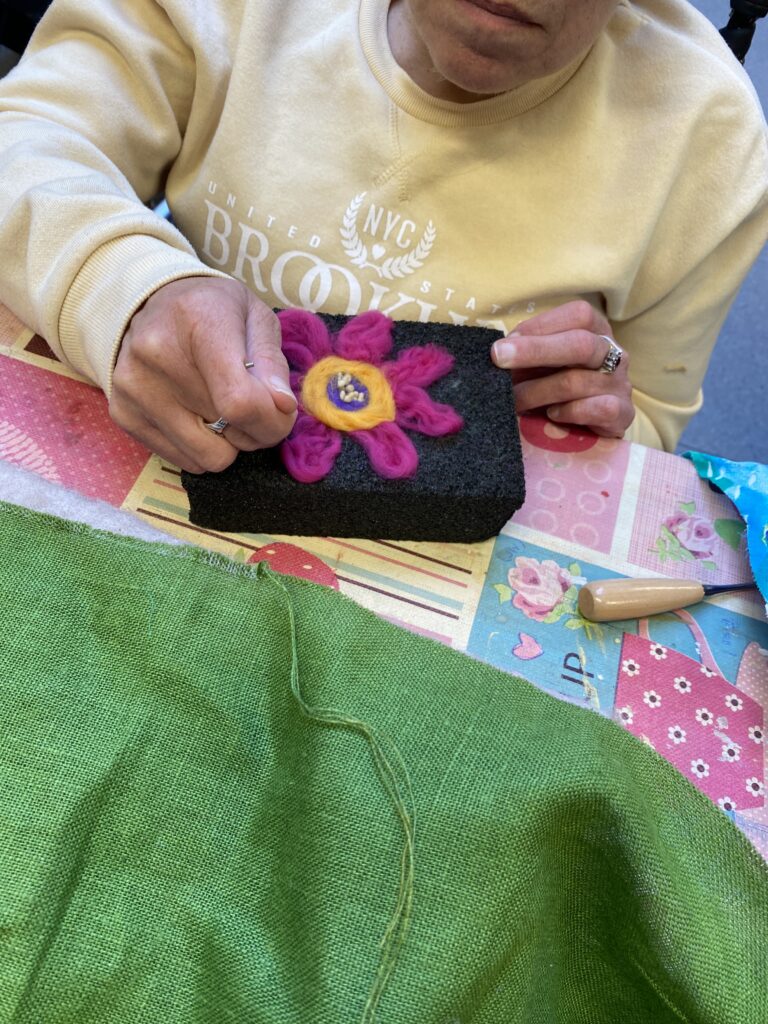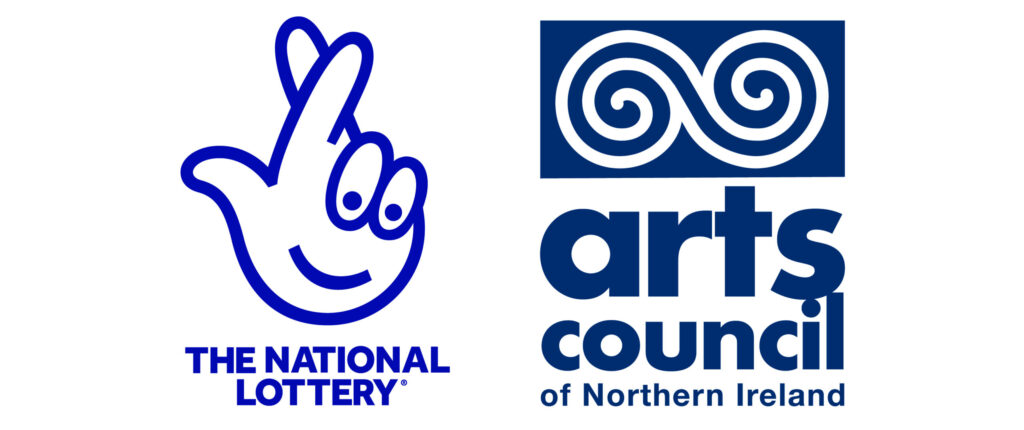Crafting Connections: The Power of Art in Complex Care
Geraldine Carragher, Manager at Millview and Windsor Day Centres, shares how Arts Care artist Caroline Shimmons has transformed the atmosphere and engagement among service users. Through creative sessions that adapt to each individual’s needs, Caroline’s work has fostered independence, pride, and a renewed sense of community for service users across both centres.
Perhaps it helped that the day I visited Millview Day Centre in Bessbrook was particularly sunny? The sky was blue, the birds were chirping, and people were smiling and waving cars out of junctions with the enthusiasm of an Irish person on a rare summery day.
A Welcoming Atmosphere
However, I firmly believe that the sunshine attitude remains in Millview year-round.
When I arrived, the morning art-making session with Arts Care artist Caroline Shimmons was just underway, the group gathered around the large worktable, enthusiastically rolling felt and chatting animatedly.
This is a well bonded group, with several members having attended sessions here for some time, so they are friendly and supportive of each other, have a great rapport with the centre staff, and are familiar with the process of working with a visiting artist.
I enquire as to what types of artmaking they have undertaken in the past and am treated to an impressive list of mediums and techniques – all manner of textiles, ceramics, painting and even working with copper were mentioned.
When I ask what their favourite is, I get a different answer from almost everyone – some like embroidery, others like textiles but definitely NOT sewing, some prefer working with clay or painting. The staff join in the conversation too – many of them provide hands on assistance to members of the group, so have found techniques they personally enjoy too, as well as identifying ones which meet the needs of various group members well.
Embracing Creativity
One member sums up her have-a-go attitude, which I see reflected around the room during the morning, telling me “When I was a girl my mother always told us ‘Don’t say you can’t do something until you try. And if you try and you still can’t, then try again!’” She tells me that at home, she can often be found in the room that her husband refers to as ‘her office’, where she spends hours crafting.
She has learned a wide range of skills over the years, through day centre sessions, and community classes, and she values the time she gets to spend practising these, and the items she is now able to make both for her own enjoyment, and more importantly as gifts for family, friends and neighbours.
Art as a Tool for Independence
Geraldine Carragher, Day Centre Manager, tells me that this is an important part of the point of working in this way. She says: “Some of our service users’ mental health can be quite low at times. But activities like these can help build that independence – it gives people goals, and they can learn skills they can use at home.
“For some people, when they aren’t here they aren’t going out and about many places, but that creativity allows them to carry on with projects and to continue to feel the sense of achievement they have discovered in sessions with us and our visiting artists.
“It makes a huge difference the artists coming. It’s a different face, to begin with! The staff like having the artists coming in too – they are able to tell our service users about the artist who is coming, and get them excited, and lets them relate to the service users in a different way during the sessions.
“We find folk look forward to the artists coming each week – they anticipate the visits, and can be sad when the project ends. But even that allows us to help them build their confidence and enthusiasm and help them look forward to the next project or the next visit – you know, ‘look how much you enjoyed that activity, and how much you learned – imagine what you’ll do next’ kind of conversations.
“The diversity in activities is great – we get the opportunity to try out so many different types of work that we would not be able to undertake just with our own staff. The skill level of the artists coming in is wonderful, so our service users are able to enjoy really good quality teaching. Our staff benefit from that too – they are upskilling with new techniques and materials and ways of working, so they can maintain activities and interest with service users going forward.
“The benefit to our service users is so clear. You can see their enjoyment, in themselves and in their manner, but also in the work, and in the finished pieces when they are displayed. The value for their mental health and their well being with that sense of achievement, the pride and the ‘Look what we did!’ – it is just brilliant.”
A Tactile Reminder of Achievements
Geraldine and I head back in to catch the tail end of the art making sessions. The participants have been making felt pieces – simple images that represent them. It becomes clear that many of them have chosen images from nature – we have butterflies and rainbows, and flowers, and lots of colour.
Participants have chosen imagery and colours and have physically rolled up their sleeves to create felt pieces through agitation and movement, sometimes with staff support, sometimes independently. There has been actual energy as well as creative effort put into these creations, and everyone looks delighted with their outcomes. Each piece will be added to a wall hanging, stitched onto fabric, adorned with embroidered stitches and beads, as a tactile, colourful reminder of the sunny days and creative adventures in Bessbrook.
Afternoon Sessions at Windsor
As the day progresses, I accompany Caroline to another day centre in the area – the afternoon session is spent with the service users in Windsor Day Centre in Newry.
Geraldine explains: “This centre provides services for people with complex disabilities, learning disabilities and brain injuries. People attending here require a lot of support, compared to this morning in Millview.
“Often she works one-to-one, for short periods of time; the sessions are intense, and each simple achievement or impact is to be celebrated. It is challenging work, in a busy centre, but gradually she is seeing the impact her work is beginning to have so service users, staff and carers.
Adapting Art for Individual Needs
Geraldine Carragher explains: “The situation in Windsor is different to what we saw earlier in Millview. We don’t have the same kind of group sessions as we have there, as people attending Windsor require much more support and the work needs to be more individual. One-to-one is much more intense. But the impact on people can, I feel, be even greater because of that.
“Because the work requires such a high level of support, people get to do activities when artists come in that they just couldn’t do with the regular staff. We simply couldn’t provide that level of support otherwise.”
The Power of Flexibility and Inclusion
As we talk on, the contrast between the two groups, and the two types of work becomes more clear, and I am struck by the adaptability required by our artists, to enable them to transfer ideas, materials and techniques to such meet such a board range of needs. But I am even more clearly struck by how this breadth of participation is the most vital element in the work on Windsor in particular.
As Geraldine explains: “People who come into our complex care facilities, in a lot of ways that are not really included in wider society. And so their worlds can become very small – very often they have a very clear routine and a short list of places they go. They see the same faces.
“So on a very basic level, having a new face come in to the centre, and a change in routine – a new activity on offer, that is huge. And when that person is a professional artist, with all the experience and creativity and skill that they bring – new skills and movements, new materials, new opportunities… That is so important.
“Caroline is working with textiles at the minute, and that is wonderful – not only is she very skilled, but we can we also think about how well people’s sensory needs are being met by that. Touching the materials and the feel of using their hands in that way, it is another level of care and support.”
One-to-One Art-Making and Care
I sit in on the session with Caroline. We have three service users actively participating in activities, each requiring a high level of one-to-one support from staff. A number of other service users come in and out of the session as it progresses. Some stay to watch for a while, some touch some materials, some are disinterested in any of the activity in the room, but crave the company and to listen to the chat.
All very different needs, presenting a wide range of challenges, and despite the low attendance numbers compared to the morning session, I am struck by what a demanding afternoon it is. I am also taken by the level of care Caroline takes with meeting each of those needs, keeping conversation going, ensuring both service user and staff member feel confident in what they are doing, and are aware of their achievements at each step of the way.
“The success for individuals are clear, and quite measurable. People do more for a new person, a new face. They can focus for longer, and interactions can be more intense. It’s just so valuable.”
Creating Lasting Impressions
Caroline is creating a wall hanging for this centre too, made up of a series of small panels of textile work of work, produced using a range of techniques and materials. Geraldine is delighted with the plan, telling me “The environmental aspect, improving our surroundings with artworks, is so important.
“People will see their work every day as they pass it, and that sense of pride and familiarity, seeing themselves on the wall, is wonderful.
“I can’t say enough how important this work is, and it saddens me that people don’t value this kind of input into people’s lives enough.”
Case Study by Ali Fell on behalf of Arts Care






